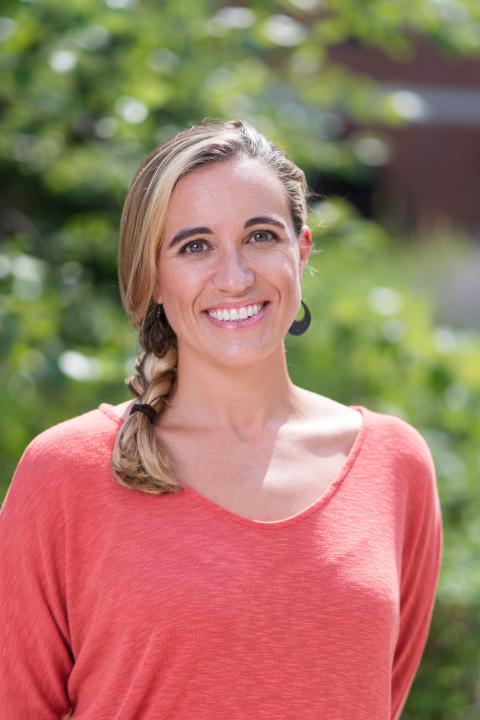
<p>Jill Thorson, PhD, is an Assistant Professor in the University of New Hampshire’s Department of Communication Sciences and Disorders. Her research asks “How do children acquire language?” and focuses on the perception and production of prosody (i.e., the melody and rhythm of speech) at different stages in development, and how these early language processes impact successful communication. The goal of her work is to provide a better understanding of how the complex interaction between prosody and meaning develops over infancy and early childhood in both typical and atypical developing population. Past work has explored how prosody impacts early word learning as well as how the acoustic correlates of prosody are realized in the speech of minimally verbal school-aged children with autism. Additionally, she is interested in the role of prosody in the diagnosis and treatment of motor speech disorders. These lines of research not only inform how language and learning difficulties are classified across disorders but also offer insight into intervention, treatment, and earlier diagnosis.</p>
<p><br>Dr. Thorson’s current work is centered on how to more naturally assess prosodic abilities across the lifespan with funding from a pilot project from NH-INBRE, an NIH IDEA grant. Her work has been widely published in top peer-reviewed journals, and she received the UNH College of Health and Human Services Teaching Award in 2024. Actively engaged in the American Speech-Language-Hearing Association, Acoustical Society of America, and Speech Prosody special interest group, she contributes to advancing foundational science and evidence-based assessment strategies in communication sciences and disorders. </p>
<p><br>She is also the Director of the Communication, Acquisition, and Translational Studies Laboratory (CAT Lab) at UNH. See above for link to website and details on current studies.</p>
Courses Taught
- COMM 522: Language Acquisition
- COMM 524: Clinical Phonetics
- COMM 798/895: SpcTopic/Child Lang Acquistion
- COMM 842: Autism Spectrum Disorders
- INCO 590: Student Research Experience
- INCO 790: Advanced Research Experience
Research Interests
- Acoustics
- Autism
- Communicative Disorders, Speech
- Language Acquisition and Development
- Linguistics
- Assessment development and validation
Selected Publications
Thorson, J. C., & Burdin, R. S. (2024). Phonetic implementation and the interpretation of downstepping in Mainstream US English. Journal of Phonetics, 105, 101340. doi:10.1016/j.wocn.2024.101340
Thorson, J. C., Trumbell, J. M., & Nesbitt, K. (2024). Caregiver and child question types during a museum interaction.. Front Psychol, 15, 1401772. doi:10.3389/fpsyg.2024.1401772
Thorson, J. C., Franklin, L. R., & Morgan, J. L. (2023). Role of pitch in toddler looking to new and given referents in American English.. Lang Learn Dev, 19(4), 458-479. doi:10.1080/15475441.2022.2149400
Gurevich, N., & Grindrod, C. (2022). Clinical Applications of Linguistics to Speech-Language Pathology. Routledge. doi:10.4324/9781003045519
Miller, M., Thorson, J., & Robertson, P. (2022). Categorical Preference of the Mind. Journal for the Cognitive Science of Religion, 8(1), 2-31. doi:10.1558/jcsr.20462
Thorson, J. C., & Morgan, J. L. (2021). Prosodic realizations of new, given, and corrective referents in the spontaneous speech of toddlers. JOURNAL OF CHILD LANGUAGE, 48(3), 541-568. doi:10.1017/S0305000920000434
Thorson, J. C. (2019). Prosody. In M. J. Ball, & J. Damico (Eds.), The SAGE Encyclopedia of Human Communication Sciences and Disorders. Thousand Oaks, California: SAGE Publications.
Thorson, J., Meyer, S., Plesa-Skwerer, D., Patel, R., & Tager-Flusberg, H. (2016). Assessing prosody in minimally to nonverbal children with autism. In Speech prosody Vol. 2016 (pp. 1206-1210). doi:10.21437/speechprosody.2016-248
Thorson, J., Borras-Comes, J., Crespo-Sendra, V., del Mar Vanrell, M., & Prieto, P. (2015). The acquisition of melodic form and meaning in yes-no interrogatives by Catalan and Spanish speaking children. Probus, 27(1), 73-99. doi:10.1515/probus-2013-0019
Prieto, P., Estrella, A., Thorson, J., & Vanrell, M. D. M. (2012). Is prosodic development correlated with grammatical and lexical development? Evidence from emerging intonation in Catalan and Spanish.. J Child Lang, 39(2), 221-257. doi:10.1017/S030500091100002X
